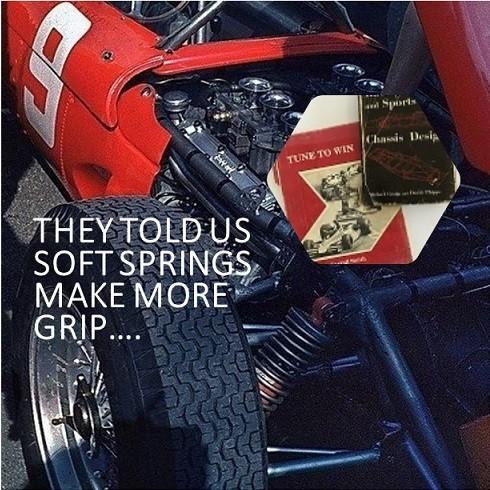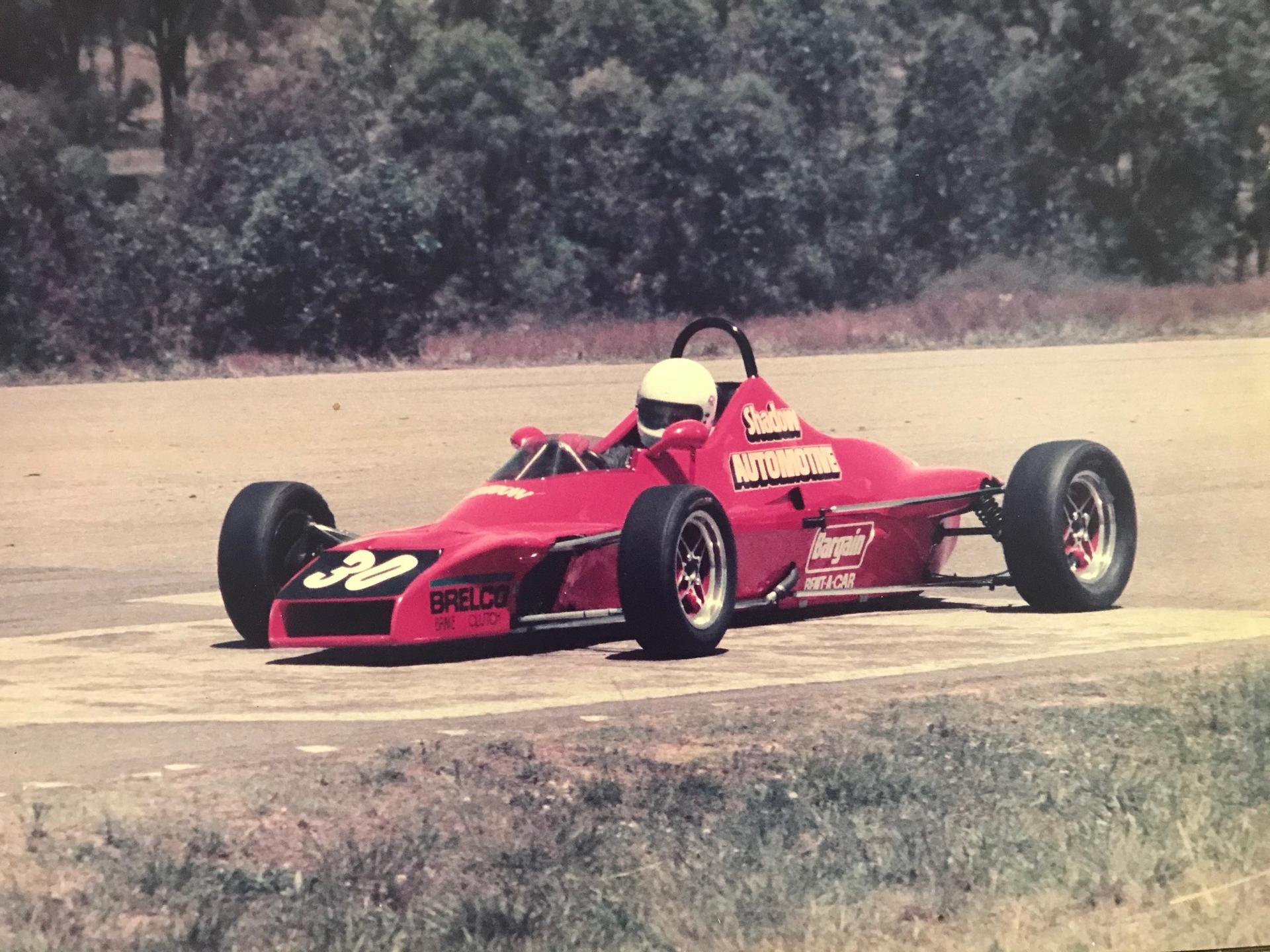THE INCREDIBLE STORY OF GRIP - 1960's TO NOW..
They thought soft springs like a road car would make best grip....
The Race Car Designers (and the Pundits) Said We Needed Soft Springs for Grip....
In the 1960s racing cars were fitted with very soft springs. The books on racing, such as Costin and Phipps "Chassis Design" and Carroll Smith's "Tune to Win" all supported soft springs, and nobody questioned it.
Racer's thought spring rates should be as soft as possible - helping to make grip by allowing the tyre to keep in constant contact with the road surface.
E.G. You might've reduced the spring rate in the rear of the car with the intention of getting more drive in the corner exit. Wrong thinking as it turns out. (Note: In modern professional racing where they already have massively stiff springs to support the high aero downforce, different rules apply.)
It took decades for us to break away from the soft spring thinking. Now the evidence is in. From the hundreds of set-ups we and our clients have done at Racing Car Technology, it works out we need substantially stiffer racing springs to make grip at the tyre contact patch.

My Bowin P4A - Change to Slicks Hurts Grip
Early Formula Fords in Australia ran on a Goodyear RR12 control tyre before they changed to a Goodyear slick in 1974, as shown in the photo.
Bowin P4as (my car leading in the picture) won the championship in 1972 and 1973, but were about a second slower per lap on the slicks. Chassis flex and soft springs killed the grip on this new high grip tyre. The car worked better on the old tyre.
Some of the cars, those with stiffer chassis, such as Peter Finlay's Palliser, loved the grippier tyre and performed better.
The factory ran test days with all the Bowin drivers, but did not come up with anything to fix the cars.
We could've been much faster if we'd fixed the really bad chassis compliance and fitted stiffer springs.
In 1976, with a change to road radials as the control tyre, the P4As were again a front running car.
Australia's Most Famous Touring Cars
Pete Geoghegan and Allan Moffat. Check the crowd!
Geoghegan in usual pose - way too much pitch and roll. Moffat's Boss 302 Mustang much flatter,
Of course Geoghegan's Mustang needs to be stiffer. But what about Moff? He 's probably got around 750 lb/in front springs. Might sound stiff. But today we gain heaps more grip with springs considerably stiffer again.
Our PRS82F - Too Much Flex and Soft Springs Kill Grip
Neville and I bought our PRS 82F from the local importer in 1983. None of the 82Fs in Australia or America were fast. The Designer came out from Italy, but made no suggestions as to how to fix the cars. The cars had very poor motion ratios for front springs and anti-roll bar. So the suspension was road car soft on what were acceptable springs and anti-roll bars in other cars.
But the car could have been fixed quite easily, but unfortunately we missed the clue as to what happens with stiffer springs. At one point I had the strangest experience when the front suspension rocker bound up in the middle of a long corner. Immediately I sensed increased grip. I could turn in harder, even accelerate momentarily. The bound up suspension instantly provided the resistance the tyre needed to create more grip. (This could only work at the time it happened - could not reproduce by driving around to the same corner again)
At the time, with our ingrained soft spring thinking, we had no idea what just happened.

Today, Pro Racing spring tech all sorted. But what about Grassroots Racing?
In Pro racing aero downforce changes everything. Different criteria are involved in spring selection.
Non-aero spring tech for Grassroots Racers has been left behind. But now we've developed new guidelines for suspension stiffness, so that any racer can work out the springs needed for best grip.

Optimizing Race Car Spring Stiffness for Best Grip
At Racing Car Technology, we've developed methods and procedures where we can specifically target the suspension stiffness that we have proven produces most grip. Racing springs alone can contribute seconds improvement in lap time due to the extra grip available compared to what we might consider a catalogue sports sports spring.
Of course, you do need acceptable settings for the suspension geometry. But after that, the single most important element of your set-up is to optimize the spring stiffness for the front and rear suspension.
Stiffer springs make more dynamic grip by reducing the tyre load variations. at the tyre contact patch. The average dynamic load is greater, compared to softer springs that spend more time unloaded.
You can’t tell if the springs are stiff enough, just by driving a few quick laps and seeing what the car feels like. You may know what spring rates you run, and even the spring rates of the fastest drivers in your category. Spring rates alone won’t tell us how stiff the suspension is because of what’s known as the “motion ratio” (MR), the distance the spring moves for a given wheel displacement (MR = spring displacement divided by wheel displacement).
What we need is a measure of suspension stiffness that’s comparable between all race cars (and road cars as it turns out.) With known suspension stiffness comparisons and before and after track testing, we can determine what suspension stiffness works best.
The measure we are talking about is the “undamped natural frequency” of the suspension, measured in cycles per minute (CPM) i.e. If there was no friction and with the shocks removed from the car, if you displace the suspension (say, pushed down on the body), the car would bounce up and down indefinitely. The suspension frequency in CPM is the number of times the car would bounce up and down in one minute. Stiffer springs make the car bounce faster.
Most racers don’t know their spring frequencies and therefore cannot know how close they are to a suspension stiffness optimized for grip. Knowing these numbers allows you to evaluate your options in improving your car.
At Racing Car Technology, measuring suspension frequency and optimizing spring stiffness has been central to what we do in suspension set-up. We've developed our methods and procedures on spring selection way beyond what's in any of the suspension books or on offer to racers via the suspension aftermarket.
You can learn all about selecting springs for ultimate best grip in our on-line training course, "Get More Grip - What Springs Do You Need?"
- We show you how to measure suspension frequency accurately for all racing cars out there. The old recommended method of measuring a lever arm ratio is too rough to be useful.
- You can do all the calculations with our Excel spreadsheet. No maths skills or hand calculation required.
- There is on-line help within the course. We can discuss specific requirements for your race car.
Please click below for more information and access to all our vehicle dynamics and suspension set-up on-line training:
All On-Line Training Courses from Racing Car Technology